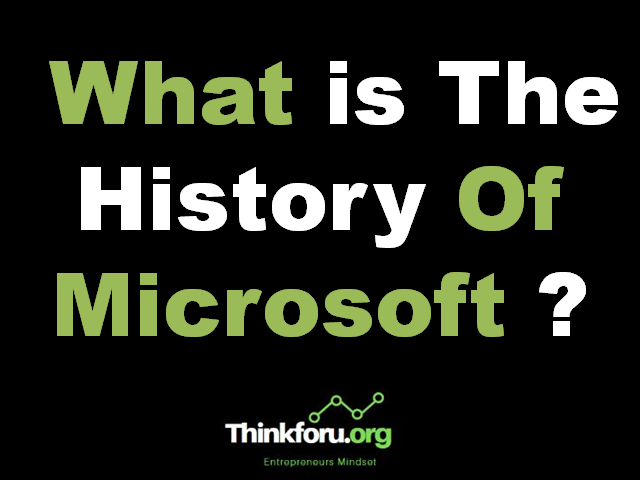Microsoft, founded by Bill Gates and Paul Allen, has a rich history that spans several decades.
Here is a brief overview of the key milestones in the history of Microsoft:
1. Formation (1975):
Bill Gates and Paul Allen founded Microsoft on April 4, 1975, in Albuquerque, New Mexico. Their initial focus was on developing a version of the BASIC programming language for the Altair 8800, one of the first personal computers.
2. MS-DOS (1980):
Microsoft's big break came when they signed a deal with IBM to provide an operating system for their upcoming personal computer. Microsoft purchased an existing operating system called QDOS (Quick and Dirty Operating System) and modified it to create MS-DOS (Microsoft Disk Operating System). This became the foundation for Microsoft's success in the operating system market.
3. Windows (1985):
Microsoft released its graphical operating system, Windows 1.0, in 1985. While it faced initial skepticism, subsequent versions like Windows 3.0 (1990) and Windows 95 (1995) achieved significant success, establishing Microsoft as a dominant force in personal computing.
4. Microsoft Office (1989):
Microsoft Office, a suite of productivity software including Word, Excel, and PowerPoint, was first introduced in 1989. It became a standard in business and personal use, contributing significantly to Microsoft's revenue.
5. Internet Explorer and Web Expansion (1990s):
Microsoft entered the web browser market with Internet Explorer, challenging Netscape Navigator. This period also saw the release of Windows 98 and Windows 2000, solidifying Microsoft's position in the PC market.
6. Antitrust Lawsuit (1990s):
In the late 1990s, Microsoft faced a high-profile antitrust lawsuit, United States v. Microsoft Corporation. The U.S. Department of Justice accused Microsoft of anticompetitive practices, including bundling Internet Explorer with Windows. In 2001, Microsoft reached a settlement with the government.
7. Xbox (2001):
Microsoft entered the gaming industry with the release of the Xbox console in 2001. The Xbox brand has since become a major player in the gaming market.
8. Windows XP, Vista, 7, and 8 (2001-2012):
Microsoft continued to release new versions of its flagship operating system, with varying degrees of success. Windows XP (2001) was particularly popular, while Windows Vista (2007) faced criticism. Windows 7 (2009) and Windows 8 (2012) followed.
9. Satya Nadella Era (2014 - Present):
Satya Nadella became Microsoft's CEO in 2014, succeeding Steve Ballmer. Under Nadella's leadership, Microsoft shifted its focus towards cloud computing and services. Azure, Microsoft's cloud platform, saw significant growth.
10. Windows 10 (2015):
Microsoft introduced Windows 10, a more unified and user-friendly operating system that aimed to bridge the gap between traditional desktop computing and mobile devices.
11. Acquisitions and Innovations:
Microsoft has made numerous acquisitions, including LinkedIn (2016) and GitHub (2018), and has continued to innovate in areas such as artificial intelligence, mixed reality (HoloLens), and cloud computing.
Today, Microsoft is a global technology giant with a broad portfolio of products and services, ranging from operating systems and productivity software to cloud computing and gaming.
